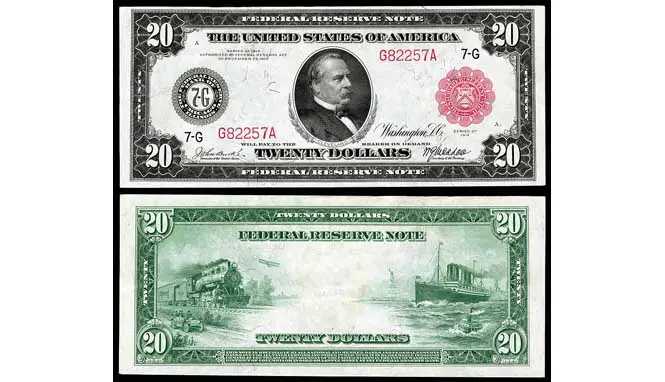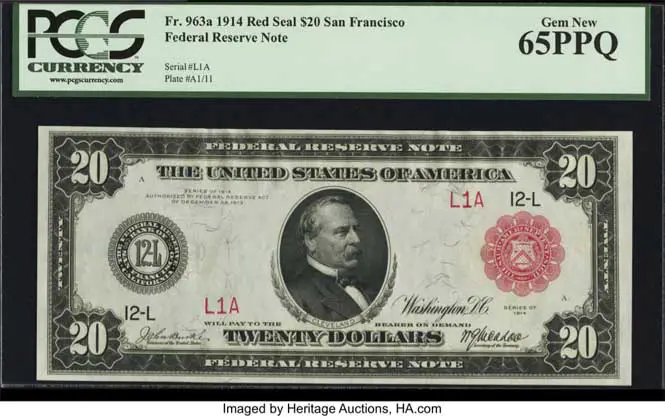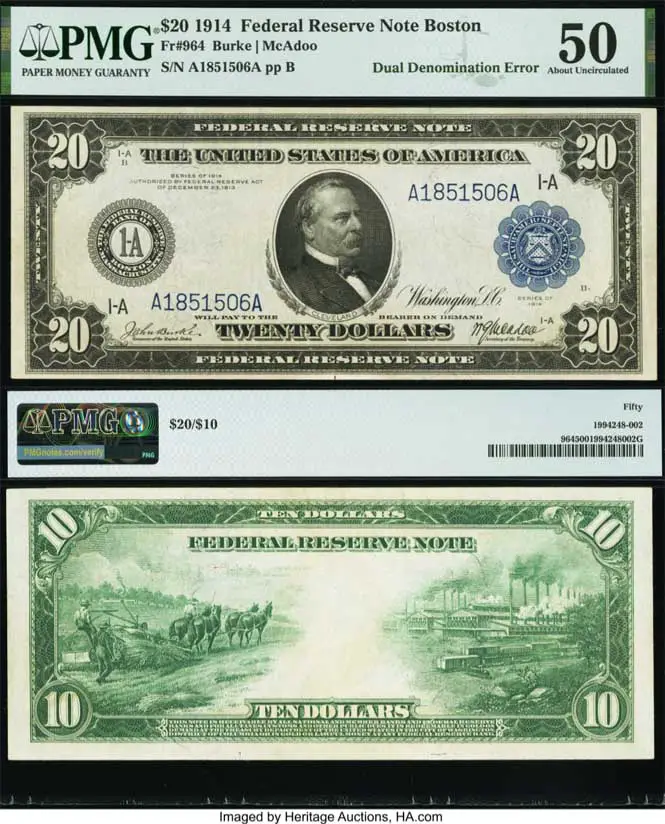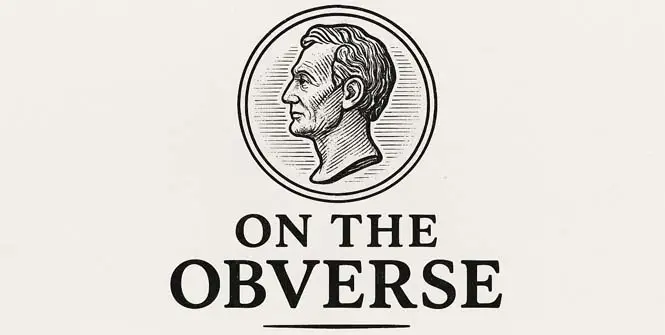- Home
- US $20 Bill
- 1914
1914 20 Dollar Bill Value: How Much Is This $20 Note Worth?
What's the value of the 1914 20 Dollar Bill? It could be worth around $100,000.
Does it have a red or blue seal? It makes a big difference to the value of this Federal Reserve Note. Notes with a red seal demand a higher premium due to their rarity.
Nearly all circulated $20 bills from 1914 are worth more than face value and uncirculated versions in fine condition are worth a lot more.
Blue Seal Value Chart
| District | F-12 | VF-20 | EF-40 | Unc-63 |
|---|---|---|---|---|
| Boston | $100 | $175 | $350 | $2500 |
| New York | $100 | $175 | $350 | $1500 |
| Philadelphia | $100 | $175 | $350 | $850 |
| Cleveland | $100 | $175 | $350 | $850 |
| Richmond | $100 | $175 | $350 | $975 |
| Atlanta | $100 | $175 | $350 | $850 |
| Chicago | $100 | $175 | $350 | $850 |
| St. Louis | $100 | $175 | $350 | $875 |
| Minneapolis | $100 | $175 | $350 | $875 |
| Kansas City | $100 | $165 | $300 | $875 |
| Dallas | $100 | $170 | $400 | $950 |
| San Francisco | $100 | $175 | $325 | $1450 |
On average a 1914 $20 bill with a blue seal is worth $175 for a Very Fine (20-35), $350 for an Extremely Fine (40-45) and $900 for a Choice CU (63).
Red Seal Value Chart
| District | F-12 | VF-20 | EF-40 | Unc-63 |
|---|---|---|---|---|
| Boston | $650 | $1350 | $3600 | $8500 |
| New York | $550 | $950 | $2500 | $8500 |
| Philadelphia | $550 | $850 | $5000 | $8500 |
| Cleveland | $575 | $850 | $2850 | $8500 |
| Richmond | $1100 | $2000 | $4850 | $13000 |
| Atlanta | $1100 | $2500 | $7350 | $13000 |
| Chicago | $600 | $1250 | $3300 | $12000 |
| St. Louis | $550 | $1700 | $4500 | $12000 |
| Minneapolis | $600 | $1275 | $4550 | $12000 |
| Kansas City | $600 | $1565 | $4300 | $12000 |
| Dallas | $550 | $1500 | $8000 | $12000 |
| San Francisco | $1100 | $3175 | $7325 | $11450 |
On average a 1914 $20 bill with a red seal is worth $1300 for a Very Fine (20-35), $4500 for an Extra Fine (40-45) and $11000 for a Choice CU (63).
Determining The 1914 Twenty Dollar Federal Reserve Note Value
When calculating the value of a 1914 20 dollar bill, numerous elements will be taken into consideration including condition, seal, signatories, issuing bank and pieces known to exist.
According to the Friedberg Numbering System for U.S. Banknotes there are 22 different 1914 series twenty dollar bills with a red and 56 with a blue seal.
Throughout the history of paper currency in the United States, dollar bills for example, have had lots more variation designs and changes compared to coins.
Not only do the pictures on the bills change, but also the series and the names of the important people who sign them.
This has made collecting paper money a bit confusing because there are so many different versions.
To help make sense of collecting paper money, a highly knowledgeable guy named Robert Friedberg (who lived from 1912 to 1963) came up with a way to organize all the U.S. money.
He gave a special number to each type of note and wrote a guide book called "Paper Money of the United States" in 1953.
So, in summary, there are a total of 78 different versions of the 1914 20 dollar federal reserve note all with varying values.
There were also star varieties issued for this year, although it's not known how many still exist.
1914 Twenty Dollar Bill Serial Number Lookup
- Series: 1914
- Denomination: $20 USD
- Varieties: (2) Red, Blue
- Signature Varieties: (4) Burke - McAdoo, Burke - Glass, Burke - Houston, White - Mellon
- FRB Varieties: (12) Boston (A), New York (B), Philadelphia (C), Cleveland (D), Richmond (E), Atlanta (F), Chicago (G), St. Louis (H), Minneapolis (I), Kansas City (J), Dallas (K), San Francisco (L)
What Does The 1914 20 Dollar Note Look Like?

Image Courtesy of National Numismatic Collection at the Smithsonian Institution (Unedited CC)
The banknote displayed above is cataloged by the Friedberg Numbering system as 958A.
It was distributed for circulation by the Federal Reserve Bank of Chicago which you can tell from the 7-G on the black district seal to the left of the portrait of Grover Cleveland and also at end of the serial number.
Also on the face is the date, Washington D.C., and the obligation: AUTHORIZED BY FEDERAL RESERVE ACT OF DECEMBER 23, 1913.
At the bottom center it reads: THE UNITED STATES OF AMERICA WILL PAY TO THE BEARER ON DEMAND TWENTY DOLLARS.
This version has a red seal and was signed by the Treasurer of the United States John Burke and Secretary of the Treasury William McAdoo.
This was the first year that the United States Federal Reserve Bank produced paper currency.
On the reverse is an image of a Steamship and Locomotive.
The early United States Twenty Dollar notes were known as large size with dimensions of 7.50 by 3.125 inches.
Highly Valuable 1914 $20 Federal Reserve Notes
Some series of 1914 notes become highly collectible if they are rare, have a fancy serial number or include some kind or error.
Here is a good example of a rare FRN sold by Heritage Auctions in 2011 for $86,250.

What makes it so valuable? The main reason is that it is a serial number 1.
Only three red seal, serial number 1, notes are known to exist.
Another reason the bill is worth more is the quality. It has been graded by PCGS as Gem New 65PPQ and is in perfect condition without a single fold.
This note was distributed by the Federal Reserve Bank of San Francisco and is cataloged as Fr. 963a.

Here is good example of a valuable error note.
This is a $20/$10 Double Denomination Error Fr. 964.
The obverse of the note is a 1914 Twenty with blue seal printed for the Federal Reserve Bank of Boston and the reverse is a 1914 Ten.
It is graded by PMG About Uncirculated 50 and sold for $44,400 on May 6, 2022 at Heritage Auctions.
Discover more about paper currency and coin collecting at Lost Treasure HQ.

Would You Like To Receive More Exciting News And Information About Coin Collecting Direct To Your Inbox?
Enter your email address below, check the boxes and click Send It To Me! now to get your FREE copy of On The Obverse newsletter.


